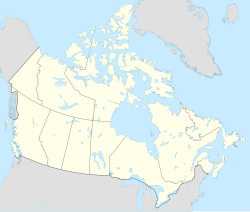Kakisa
Kakisa
K'ágee | |
|---|---|
First Nation - Designated Authority (Ka'a'gee Tu First Nation) | |
| Coordinates: 60°56′24″N 117°24′51″W / 60.94000°N 117.41417°W | |
| Country | Canada |
| Territory | Northwest Territories |
| Region | South Slave Region |
| Constituency | Deh Cho |
| Census division | Region 4 |
| Settled | 1962 |
| Government | |
| • Chief | Lloyd Chicot |
| • Council Manager | Ruby Landry |
| • MLA | Ronald Bonnetrouge |
| Area | |
| • Land | 94.80 km2 (36.60 sq mi) |
| Population (2016)[1] | |
• Total | 36 |
| • Density | 0.4/km2 (1/sq mi) |
| Time zone | UTC−07:00 (MST) |
| • Summer (DST) | UTC−06:00 (MDT) |
| Canadian Postal code | |
| Area code | 867 |
| Telephone exchange | 825 |
| - Living cost | 137.5B |
| Sources: Department of Municipal and Community Affairs,[2] Prince of Wales Northern Heritage Centre,[3] Canada Flight Supplement[4] ^A Postal code shared with Hay River ^B 2013 figure based on Edmonton = 100[5] | |
Kakisa[pronunciation?] (Slavey language: K’agee[pronunciation?]; between the willows) is a "Designated Authority"[6] in the South Slave Region of the Northwest Territories, Canada. The community is located on Kakisa Lake, and is southeast of Fort Providence. Originally located at Tathlina Lake, the community moved, in 1962, to the present location in order to be closer to the Mackenzie Highway and is linked by a 13 km (8.1 mi) all-weather road.[7]
Demographics
[edit]
|
| ||||||||||||||||||||||||||||||||||||||||||
| Sources: NWT Bureau of Statistics (2001–2012)[16] | |||||||||||||||||||||||||||||||||||||||||||
In the 2021 Census of Population conducted by Statistics Canada, Kakisa had a population of 39 living in 14 of its 19 total private dwellings, a change of 8.3% from its 2016 population of 36. With a land area of 95.14 km2 (36.73 sq mi), it had a population density of 0.4/km2 (1.1/sq mi) in 2021.[15]
The majority of the community reported First Nations status. The main languages in the community are South Slavey and English.
Services
[edit]Royal Canadian Mounted Police services are provided through Fort Providence and no health services are available. There is a single grocery store, the "River Front Convenience Store-Motel" which serves visitors to the nearby Lady Evelyn Falls. Education, up to Grade 9, is provided by Kakisa Lake School.[17][18]
First Nations
[edit]The Dene of the community are represented by the Ka'a'gee Tu First Nation and belong to the Dehcho First Nations.[19][20]
References
[edit]- ^ a b c "Population and dwelling counts, for Canada, provinces and territories, and census subdivisions (municipalities), 2016 and 2011 censuses – 100% data (Northwest Territories)". Statistics Canada. February 8, 2017. Retrieved February 1, 2022.
- ^ "NWT Communities - Kakisa". Government of the Northwest Territories: Department of Municipal and Community Affairs. Retrieved 2014-01-29.
- ^ "Northwest Territories Official Community Names and Pronunciation Guide". Prince of Wales Northern Heritage Centre. Yellowknife: Education, Culture and Employment, Government of the Northwest Territories. Archived from the original on 2016-01-13. Retrieved 2016-01-13.
- ^ Canada Flight Supplement. Effective 0901Z 16 July 2020 to 0901Z 10 September 2020.
- ^ Kakisa - Statistical Profile
- ^ Differences in Community Government Structure
- ^ Northwest Territories Bureau of Statistics
- ^ "1981 Census of Canada: Census subdivisions in decreasing population order" (PDF). Statistics Canada. May 1992. Retrieved February 1, 2021.
- ^ "1986 Census: Population - Census Divisions and Census Subdivisions" (PDF). Statistics Canada. September 1987. Retrieved February 1, 2022.
- ^ "91 Census: Census Divisions and Census Subdivisions - Population and Dwelling Counts" (PDF). Statistics Canada. April 1992. Retrieved February 1, 2022.
- ^ "96 Census: A National Overview - Population and Dwelling Counts" (PDF). Statistics Canada. April 1997. Retrieved February 1, 2022.
- ^ "Population and Dwelling Counts, for Canada, Provinces and Territories, and Census Subdivisions (Municipalities), 2001 and 1996 Censuses - 100% Data (Northwest Territories)". Statistics Canada. August 15, 2012. Retrieved February 1, 2022.
- ^ "Population and dwelling counts, for Canada, provinces and territories, and census subdivisions (municipalities), 2006 and 2001 censuses - 100% data (Northwest Territories)". Statistics Canada. August 20, 2021. Retrieved February 1, 2022.
- ^ "Population and dwelling counts, for Canada, provinces and territories, and census subdivisions (municipalities), 2011 and 2006 censuses (Northwest Territories)". Statistics Canada. July 25, 2021. Retrieved February 1, 2022.
- ^ a b "Population and dwelling counts: Canada, provinces and territories, and census subdivisions (municipalities), Northwest Territories". Statistics Canada. February 9, 2022. Retrieved February 18, 2022.
- ^ "Kakisa – Statistical Profile (2001–2012)" (PDF). NWT Bureau of Statistics. Archived from the original (PDF) on 2014-02-02.
- ^ Kakisa Infrastructure Profile
- ^ Northwestel
- ^ Dehcho First Nations Archived 2007-02-03 at the Wayback Machine
- ^ Kakisa Archived 2008-03-02 at the Wayback Machine

